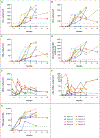Lentiviral Gene Therapy Combined with Low-Dose Busulfan in Infants with SCID-X1
- PMID: 30995372
- PMCID: PMC6636624
- DOI: 10.1056/NEJMoa1815408
Lentiviral Gene Therapy Combined with Low-Dose Busulfan in Infants with SCID-X1
Abstract
Background: Allogeneic hematopoietic stem-cell transplantation for X-linked severe combined immunodeficiency (SCID-X1) often fails to reconstitute immunity associated with T cells, B cells, and natural killer (NK) cells when matched sibling donors are unavailable unless high-dose chemotherapy is given. In previous studies, autologous gene therapy with γ-retroviral vectors failed to reconstitute B-cell and NK-cell immunity and was complicated by vector-related leukemia.
Methods: We performed a dual-center, phase 1-2 safety and efficacy study of a lentiviral vector to transfer IL2RG complementary DNA to bone marrow stem cells after low-exposure, targeted busulfan conditioning in eight infants with newly diagnosed SCID-X1.
Results: Eight infants with SCID-X1 were followed for a median of 16.4 months. Bone marrow harvest, busulfan conditioning, and cell infusion had no unexpected side effects. In seven infants, the numbers of CD3+, CD4+, and naive CD4+ T cells and NK cells normalized by 3 to 4 months after infusion and were accompanied by vector marking in T cells, B cells, NK cells, myeloid cells, and bone marrow progenitors. The eighth infant had an insufficient T-cell count initially, but T cells developed in this infant after a boost of gene-corrected cells without busulfan conditioning. Previous infections cleared in all infants, and all continued to grow normally. IgM levels normalized in seven of the eight infants, of whom four discontinued intravenous immune globulin supplementation; three of these four infants had a response to vaccines. Vector insertion-site analysis was performed in seven infants and showed polyclonal patterns without clonal dominance in all seven.
Conclusions: Lentiviral vector gene therapy combined with low-exposure, targeted busulfan conditioning in infants with newly diagnosed SCID-X1 had low-grade acute toxic effects and resulted in multilineage engraftment of transduced cells, reconstitution of functional T cells and B cells, and normalization of NK-cell counts during a median follow-up of 16 months. (Funded by the American Lebanese Syrian Associated Charities and others; LVXSCID-ND ClinicalTrials.gov number, NCT01512888.).
Copyright © 2019 Massachusetts Medical Society.
Figures


Similar articles
-
Lentiviral hematopoietic stem cell gene therapy for X-linked severe combined immunodeficiency.Sci Transl Med. 2016 Apr 20;8(335):335ra57. doi: 10.1126/scitranslmed.aad8856. Sci Transl Med. 2016. PMID: 27099176 Free PMC article. Clinical Trial.
-
Pretransplant mobilization with granulocyte colony-stimulating factor improves B-cell reconstitution by lentiviral vector gene therapy in SCID-X1 mice.Hum Gene Ther. 2014 Oct;25(10):905-14. doi: 10.1089/hum.2014.101. Hum Gene Ther. 2014. PMID: 25222508 Free PMC article.
-
Lentiviral Gene Therapy for Artemis-Deficient SCID.N Engl J Med. 2022 Dec 22;387(25):2344-2355. doi: 10.1056/NEJMoa2206575. N Engl J Med. 2022. PMID: 36546626 Free PMC article. Clinical Trial.
-
Immune Reconstitution After Gene Therapy Approaches in Patients With X-Linked Severe Combined Immunodeficiency Disease.Front Immunol. 2020 Nov 27;11:608653. doi: 10.3389/fimmu.2020.608653. eCollection 2020. Front Immunol. 2020. PMID: 33329605 Free PMC article. Review.
-
Gene Therapy for X-Linked Severe Combined Immunodeficiency: Where Do We Stand?Hum Gene Ther. 2016 Feb;27(2):108-16. doi: 10.1089/hum.2015.137. Hum Gene Ther. 2016. PMID: 26790362 Free PMC article. Review.
Cited by
-
Perspectives of current understanding and therapeutics of Diamond-Blackfan anemia.Leukemia. 2024 Jan;38(1):1-9. doi: 10.1038/s41375-023-02082-w. Epub 2023 Nov 16. Leukemia. 2024. PMID: 37973818 Free PMC article. Review.
-
Current Landscape of Gene Therapy for the Treatment of Cardiovascular Disorders.Curr Gene Ther. 2024;24(5):356-376. doi: 10.2174/0115665232268840231222035423. Curr Gene Ther. 2024. PMID: 38288826 Review.
-
In Vivo Hematopoietic Stem Cell Genome Editing: Perspectives and Limitations.Genes (Basel). 2022 Nov 27;13(12):2222. doi: 10.3390/genes13122222. Genes (Basel). 2022. PMID: 36553489 Free PMC article. Review.
-
Human T cell generation is restored in CD3δ severe combined immunodeficiency through adenine base editing.Cell. 2023 Mar 30;186(7):1398-1416.e23. doi: 10.1016/j.cell.2023.02.027. Epub 2023 Mar 20. Cell. 2023. PMID: 36944331 Free PMC article.
-
The Treatment of Primary Immune Deficiencies: Lessons Learned and Future Opportunities.Clin Rev Allergy Immunol. 2023 Aug;65(1):19-30. doi: 10.1007/s12016-022-08950-0. Epub 2022 Jul 1. Clin Rev Allergy Immunol. 2023. PMID: 35776401 Free PMC article. Review.
References
-
- Buckley RH. Molecular defects in human severe combined immunodeficiency and approaches to immune reconstitution. Annu Rev Immunol 2004;22:625–55. - PubMed
-
- Fuchs S, Rensing-Ehl A, Erlacher M, et al. Patients with T+/low NK+ IL-2 receptor γ chain deficiency have differentially-impaired cytokine signaling resulting in severe combined immunodeficiency. Eur J Immunol 2014;44:3129–40. - PubMed
-
- Puck JM, Deschênes SM, Porter JC, et al. The interleukin-2 receptor gamma chain maps to Xq13.1 and is mutated in X-linked severe combined immunodeficiency, SCIDX1. Hum Mol Genet 1993;2: 1099–104. - PubMed
-
- Buckley RH, Schiff SE, Schiff RI, et al. Hematopoietic stem-cell transplantation for the treatment of severe combined immunodeficiency. N Engl J Med 1999;340: 508–16. - PubMed
Publication types
MeSH terms
Substances
Associated data
Grants and funding
LinkOut - more resources
Full Text Sources
Other Literature Sources
Medical
Research Materials
